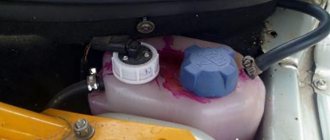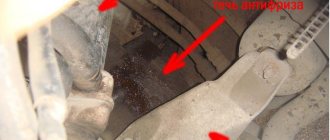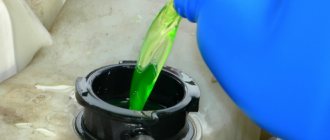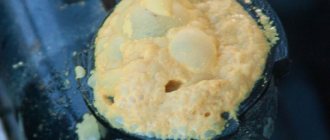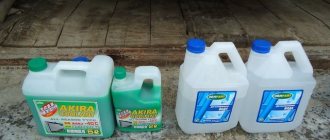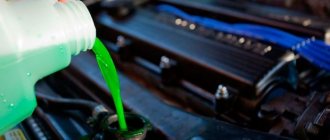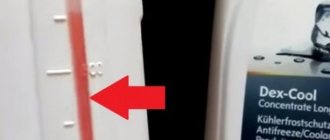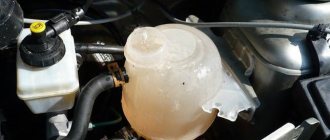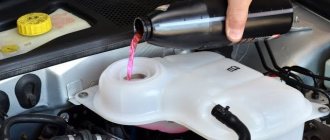G13 is a completely new antifreeze, which appeared several years ago and is considered a representative of a new generation of coolers. Its base is propylene glycol alcohol together with various mineral additives.
The moderators used in the solution do not yet have an established name. The new technical fluids are available in yellow and orange shades. Cooler standard VW TL 774 J. They are environmentally friendly, but have a significant price.
Characteristics
Antifreeze G 13 appeared in 2012. It is a representative of a new generation of antifreezes with an organic propylene glycol base in combination with mineral additives. The inhibitors used do not yet have a generally accepted name and are called “SOAT coolants” or “Lobrid coolants”. Liquid G 13 is usually yellow or orange in color. It is more environmentally friendly, so its cost is much higher than its analogues.
The fluid complies with the VW TL 774 J standard. G 13 coolant contains an increased amount of corrosion inhibitors, which meets the requirements for a fluid for use in the most modern VW engines. G13 antifreeze contains flavoring additives that prevent its consumption. Thanks to the silicates contained in the coolant, an ultra-thin anti-corrosion protective film is formed on the surface of the metal parts of the cooling system. Carbon components act selectively only in places where corrosion occurs.
A distinctive feature of G 13 antifreeze is its unlimited service life if it is poured into a new car. Coolant G 13 began to be used in 2012. In addition to being environmentally friendly and high in cost, G 13 is almost no different in its technical characteristics from G12++ with an ethylene glycol base.
The concentrate can be diluted with distilled or high-quality softened water. After dilution, the temperature limits change:
- when mixing 1:2, the freezing point is -18, boiling point - 108 degrees;
- when mixing 1:1.5, the freezing point is -24, the boiling point is 111 degrees;
- when mixing 1:1, the freezing point is -37, boiling point - 114 degrees.
G 13 can be mixed with G12, G12+ and G12++ coolants that meet VW TL 774 D, F or G standards. Due to its environmental friendliness, G13 antifreeze is widely used in European countries.
Vag
Vag G13 coolant provides protection against freezing, corrosion and overheating at the same time, which can be used throughout the year. It is fully optimized for aluminum engines. It can be mixed with the previous antifreezes G12, G12+ and G12++. The additives included in Vag G13 fluid are safe for rubber components that are part of the car's cooling system.
Vag G13 Coolant
Vag G13 fluid has the following properties:
- Protects against freezing; when properly diluted, the low temperature range is from -25 to -40 degrees.
- Provides fire safety. The boiling point of coolant is 135 degrees. The coolant stabilizes heat generation in emergency situations.
- Prevents the formation of lime deposits.
- Protects against corrosion and cavitation.
- Environmentally friendly product.
Vag G13 antifreeze is purple.
Motul Inugel
Motul inugel G13 coolants are a concentrate that requires dilution with water: distilled or high-quality drinking water. Depending on the ratio, the freezing temperature changes: at 40%! it is -22 degrees, 50%! degrees, 66%! degrees.
The basis of the liquid is monoethylene glycol and glycerin with the addition of organic and inorganic additives. During manufacturing, “lobrid” technology is used, which provides maximum protection for cooling system parts and extends their service life. Recommended for VAG vehicle group. Protects metal and aluminum engine components from corrosion, overheating, cavitation, freezing and scale. Increases the service life of the water pump.
Motul coolant
VW AUDI G13
VW AUDI G13 antifreeze is a purple concentrate that must be diluted in a 1:1 ratio. The freezing point is – 25 degrees, the boiling point is + 40 degrees. The liquid contains no silicates. There is no limitation period for use. Good compatibility with G12++ and G12+ coolants.
Main characteristics: protection against overheating, freezing, corrosion, prevents the formation of scale. Can be used throughout the year.
Coolant VW G13
Kinds
Antifreeze Vag G13
A technical mixture that protects the car engine from crystallization, corrosion processes and temperature surges at the same time. Applicable at any time of the year, goes well with aluminum engines.
The additives that are included in the structural composition of the Vag G13 technical solution are not aggressive towards the rubber components included in the cooling system of the machine.
Vag G13 antifreeze has the following characteristics:
- Protects against freezing. If the concentrate is diluted correctly, the temperature range will vary from 25 to 40 degrees below zero.
- Fireproof. The boiling point is at 135 degrees.
- Prevents precipitation;
- Eco-friendly.
Motul inugel G13
Motul Inugel G13 coolers are produced as a concentrate, which must be diluted with water. Typically purified or distilled. The base of the solution is dihydric alcohol ethylene glycol and glycerin with a large number of additives of organic and inorganic origin.
During the production process, a special “Lobrid” scheme is used, which provides maximum permissible protection for the cooling system mechanisms and extends their service life.
According to the manufacturer, the composition is recommended for use in the affordable Vag automobile line. The technical mixture perfectly protects polymer and metal surfaces in the engine from temperature fluctuations, hardening, lime, rust and increases the service life of the water pump.
Item matters
If we discard antifreezes (which also have differences), the buyer’s choice is narrowed down to three main options:
We recommend: Overheating of the automatic transmission and the use of an additional radiator
G11 – ethylene glycol group, with a limited package of additives. Economical option, color identification: green. Covers the entire internal surface with an anti-corrosion layer, which impairs heat transfer. Used in low-power engines with low maximum speeds.
G12 – ethylene glycol and carboxylate are used as antifreeze. Distinctive feature: protection against corrosion does not occur on the entire surface, but only in the necessary places. Thanks to this, heat dissipation from metal parts is improved. This antifreeze is quite expensive, but it can be used in engines with high thermal load. Color – red.
G13 – antifreeze based on polypropylene glycol. The characteristics differ little from the previous composition and have minimal impact on the environment.
The composition is expensive, so it is in low demand among car owners of used cars. G13 color is yellow, orange, or purple: depending on the type of additives and manufacturer.
Important: Color coding may not comply with generally accepted standards. Manufacturers sometimes use the dye not to identify the class, but as an advertisement for their product.
When choosing, it is not so important what color the antifreeze is. The main thing is the class (G13 or another), as well as a message on the label which additive is used as an antifreeze.
Car owners are better known for VAG G13 antifreeze, thanks to a wide range of cars.
Volkswagen AG purple antifreeze is poured into engines of AUDI, SEAT, Skoda, and Volkswagen itself. In addition to the generally accepted standard, there is a car manufacturer marking: G 013 A8J M1.
Yellow G13 antifreeze is produced by third-party manufacturers; VW does not recommend pouring it into its cars.
Approvals, tolerances and specifications
Shell Super Protection
SPECIFICATIONS:
- BMW N 600 69.0
- Bez.Reg.Arnsberg
- Energy 84.12.22.63-2001-2
- German Army TL 6850-0038/1
- Deutz H-LV 0161 0188
- Jenbacher TA-Nr. 1000-0201
- Liebherr TLV 035
- TLV 23009A
- MAN 324-NF
- MAN B&W List 3.3.7
- Maybach Specification 325.0
- Mercedes-Benz Specification 325.0
- MTU MTL 50G48
- Opel/Vauxhall (production up 2000) B 040 0240
- Porsche (production up 1995)
- Saab 6901599
- Rolls-Royce (production up 1998)
- Smart Specification 325.0
- Van Hool
- Volvo Car 1286083 Issue 002
- Volvo Truck (production till 2005)
- VW/Audi/Seat/Skoda TL 774-C
We recommend: How to replace a timing belt with your own hands
Shell Premium Antifreeze Concentrate
- BMW GS 94000;
- Cummins 85T8-2;
- Daimler MB 325.0 & 325.2;
- Chrysler MS-7170;
- Fiat-Lancia 9.55523;
- Iveco Std. 18-1830;
- Ford ESD-M97B49-A;
- MAN 324NF;
- MTU MTL 5048;
- VW TL 774-C (G11).
Shell Premium Antifreeze Longlife Concentrate
- Audi TL-774 F;
- Ford WSS-M97B44D;
- GM 6277;
- MAN 324 Type SNF;
- Seat TL-774 F;
- Scania 0-89 1027 GT ET;
- Skoda TL-774 F;
- VW TL-774 F;
- Mercedes Benz DBL 7700.02;
- MTU MTL 5048;
- Porsche TL-774 F.
SHELL Premium Antifreeze Longlife Ready to Use
- Audi/Skoda/Volkswagen/Porsche: TL-774 F;
- Ford WSS-M97B44D;
- GM 6277;
- MAN 324 Typ SNF Seat TL-774 F;
- Scania 0-89 1027 GT ET;
- MB DBL 7700.02;
- MTU MTL 5048.
Antifreeze Shell Premium Antifreeze Concentrate
Properties of antifreeze G13
Antifreezes are consumables that are used in the cooling system of a car's power unit. Their main purpose is to protect engine mechanisms from crystallization. In addition to their cooling properties, they are capable of performing a lubricating function, as well as anti-corrosion protection of parts.
G13 antifreeze contains a huge amount of anti-corrosion additives, which is an excellent indicator for liquid used in modern engines. In addition, some flavoring additives are included in the antifreeze composition so that the consumer does not accidentally confuse the compositions.
The silicates contained in antifreeze create a special protective shell on the surface layer of parts, which prevents the formation of rust stains.
More on the topic: Requirements for antifreeze, density measurement
The main difference between G13 coolers is their long service life, provided that it is integrated into a new vehicle engine system. If you miss the high cost of the product and environmental components, then the cooler is similar in its technical properties to dihydric alcohol (ethylene glycol) G12++.
The purchased concentrated solution is diluted with purified or distilled water. After the antifreeze has been diluted, its temperature changes:
- If the compositions are mixed in a ratio of 1:2, then the crystallization temperature will be minus 18 degrees, and the boiling point will be 108 Celsius;
- With the same ratio, that is, 1 to 1, the freezing point is 37 degrees Celsius, and the boiling point will approach 114 degrees Celsius.
G13 antifreeze can be mixed with coolers of earlier versions that meet VW TL 774 D, F or G standards. It is for this reason that it has become widely used in European countries.
What colors of antifreeze can be mixed with each other?
What factors does color depend on?
Due to its composition, antifreeze does not have the ability to freeze at low temperatures. It is added to the extensive tank of the cooling system of automobile transport in order to reduce the temperature of the operating mechanisms of the engine and protect them from overheating.
Any antifreeze is a chemical compound (ethylene glycol), which consists of glycols, purified water and additional additives. In its natural form, it poses a threat, since the concentrate adversely affects the resistance of engine components to corrosion processes. To avoid this, various silicates are added to the composition to reduce the effect of corrosion on the elements. It may differ according to established standards containing certain norms. These standards distinguish coolants from each other by introducing a package of additives into the solution.
The color of antifreeze is formed by introducing harmless pigments into the technical liquid. The standards do not provide for a definition of color, but there is mention of some rules:
- Only saturated colors are applicable;
- The actual color of the antifreeze can be any, the main thing is that the technical solution differs from gasoline and purified water.
These recommendations were created for a specific purpose: if coolant leaks from the cooling system tank, it will be easier for the car owner to determine that it is the coolant that is leaking due to the brightness of the color.
Antifreeze for Hyundai and Kia
Is antifreeze mixture acceptable?
So, the color depends only on the dye introduced into the solution, and this can lead to the erroneous conclusion that all refrigerants are the same. But this is not so, antifreezes differ from each other in other parameters. For example, the composition of the functional additive package is divided into four types:
- Traditional compositions: mostly no longer relevant, but are occasionally used when cars are first filled at manufacturing plants.
- G11: Mixed, including inhibitors of organic and inorganic nature.
- G12 and G12+: carboxylate-based coolants are characterized by an extended service life of more than five years.
- G-12++, G-13: antifreeze contains mineral chemical reaction inhibitors.
The coolant container always displays information about what type it belongs to. Only taking this data into account can you begin mixing different colored solutions.
If you choose on your own which colors of antifreeze you can mix, you can make serious mistakes. This is mainly due to the fact that even when mixing formulations of the same type, the remaining residue in the tank can conflict with the top-up. Eventually, the useful functions of the cooler will decrease or disappear altogether. There are always risks, even if, for example, you mix one-color G12 from different manufacturers. Therefore, it is not allowed to mix single-color and multi-color compositions; it is better to completely replace the coolant in the car system so as not to doubt the quality characteristics of the filled substance.
If you need to add coolant, you need to select the maximum possible variation. There is a simple recipe for checking compatibility. Two experimental liquids are poured into one tank. If the thickness and saturation do not change during mixing, then everything is in order. If a precipitate has formed in the mixture and the solution has become cloudy, then such technical liquid must not be used for its intended purpose.
What colors of antifreeze can be mixed, table:
| Antifreeze for topping up | Antifreeze in the system | |||||
| 99 90 1089 G1 | 99 90 2374 G11 | 99 90 1381 G12 | 99 91 9400 G12+ | 30 93 7400 G12++ | 30 93 8200 G13 | |
| 99 90 1089 G1 | + | + | — | — | — | — |
| 99 90 2374 G11 | + | + | — | — | — | — |
| 99 90 1381 G12 | — | — | + | — | — | — |
| 99 91 9400 G12+ | + | + | + | + | — | — |
| 30 93 7400 G12++ | + | + | + | + | + | + |
| 30 93 8200 G13 | + | + | + | + | + | + |
Motul Inugel
This is a concentrate that cannot be used in its pure form. It is used only after dilution. The main component is monoethylene glycol. Glycerin, organic and inorganic additives and heat are added to it.
The special technology used to make the product protects car parts and increases their service life. Coolant is especially effective against the formation of scale and corrosion on objects made of aluminum and metal. She is not afraid of freezing and overheating. A water pump with such liquid will last longer.
Advantages and disadvantages
Here are the advantages that CS G13 antifreeze can boast of:
- long service life;
- high quality corrosion inhibitors;
- protection of all types of metal, including aluminum;
- possible compatibility with G12 and other ethylene glycol liquids;
- high lubricating, cleaning, anti-foaming, anti-cavitation properties.
As a disadvantage, many car enthusiasts are put off by the price of the product, however, lobride antifreezes, by definition, cannot be cheap.
Existing types of antifreeze
A car is no longer a luxury item, but a means of transportation. People use a vehicle to go to school and work. In any weather conditions and at any time of the year, transport must function normally and without complaints. Antifreeze is a necessary product, without which normal operation of a car is almost impossible.
There are different types of refrigerants, so it is worth paying attention to their similarities and differences. Less experienced car owners are guided mainly by color, but this rule does not always apply. Antifreeze is offered on the market today in three colors:
- red;
- yellow;
- green.
We recommend: Window lifter button wiring diagram
It is not by chance that antifreeze is colored. There are several reasons for this, but the main one is the ability to quickly find a leak. Sometimes it is necessary to quickly distinguish antifreeze from another liquid, and since the composition is initially colorless, it can be confused with ordinary water.
Functions performed by antifreeze
Due to its properties, coolant is capable of performing a variety of functions. Thus, it helps remove excess heat from the internal combustion engine, and does not freeze even in very severe frosts. To evenly distribute the heat generated during operation of the power unit, antifreeze circulates through a small circle of the cooling system. This becomes possible thanks to the operation of a special pump, which is also called a pump. It is interesting that as soon as the temperature of the internal combustion engine reaches certain values, a large circle of the car’s cooling system comes into operation, and here the radiator also participates in the circulation of antifreeze. Thus, we can draw a logical conclusion: coolant is necessary for the optimal operation of the car and its key systems. It is so important that it is not possible to operate transport without it.
Antifreeze G12 and G13. What is the difference?
The vast majority of fluids intended for use in cooling systems of modern cars consist of three components:
- base dihydric alcohol (ethylene glycol or propylene glycol);
- distilled water;
- package of additives (anti-corrosion, protective, anti-foam, etc.).
Water and dihydric alcohol make up more than 85% of the total volume of coolant. The remaining 15% comes from additives.
Antifreeze class G12, according to the established classification, has three subclasses: G12, G12+ and G12++. The base for all G12 class liquids is the same: ethylene glycol and distilled water. The differences lie in the additives.
G12 antifreeze has carboxylate (organic) additives. They work exclusively to prevent pockets of corrosion and do not form a continuous protective film, like coolant class G11 (or domestic antifreeze). G12+ and G12++ fluids are more versatile. They contain both organic and inorganic additives, capable of forming a protective film on the surfaces of the cooling system, but much thinner than in the case of coolant class G11.
For G13 antifreeze, the base consists of propylene glycol and distilled water. That is, alcohol has been replaced, which ensures the composition’s resistance to freezing. Propylene glycol is much less toxic and not as chemically aggressive as ethylene glycol. However, the cost of its production is several times higher than that of ethylene glycol. In terms of performance properties, regarding work in the car’s coolant system, the difference between these alcohols is small. The additives in G13 class antifreezes are combined and are similar in qualitative and quantitative indicators to G12++ coolants.
How to spot a fake
In order not to become a victim of scammers and not to buy an unknown product that will subsequently ruin the engine, you need to know the following about the packaging of Volkswagen G13 antifreeze:
- High quality plastic.
- The lid is made in accordance with the color of the liquid, purple.
- There is a retaining ring on the lid.
- The packaging has the G13 markings embossed on the back.
- High quality labels.
- Product description in German.
- The production date and product series are stamped on the bottom.
When arriving at the store, the coolant is accompanied by the relevant documents. The seller is obliged to provide a certificate at the first request of the buyer.
Reviews
G13 appeared quite recently on our market, while in Europe they have become widespread due to their environmental friendliness. True, this affected the cost of the product - it is not cheap, so it is not so popular among domestic motorists. Below are driver reviews of this antifreeze.
| Positive | Negative |
| I replaced the coolant in my car with G13. During the entire period of operation there were no problems. The liquid remains yellow. True, I had to top it up when the coolant dropped below the minimum level by 3 cm. | In old G12 antifreezes, the freezing point is indicated at -40 degrees. Now there is a new antifreeze G13. According to its technical characteristics, its freezing point is -32. Our frosts can be even higher. I didn’t want to risk not starting the car in winter. |
| G13 is one of the ways to fight for the environment. In Europe they have been taking this seriously for a long time, which is why they switched to a new antifreeze. Few people here can afford to use this antifreeze. But, if you are the right person, you will replace your coolant with an Original VW G13. It is known that the miser pays twice. | Antifreeze G 013 is sold in concentrated form. It should be diluted according to the climatic conditions in which the car is operated. It seems that it is not profitable to sell him to divorced people, but such cases already occur. This is for those who are too lazy to dilute. But it is not known what the concentrate was diluted with. It’s better not to be lazy and dilute it yourself. |
| I asked a question to a representative of an official dealer about mixing. They said that you can mix G13 with G12++, G+ and not worry about this issue. The only thing is that you can’t add G11 - they have a different base. In general, it is better not to get carried away with topping up, since if the concentrate exceeds more than 70%!, the antifreeze loses its properties. | Official dealers claim that you need to use the liquid that was originally filled. But the light did not converge like a wedge on G13. It hits your pocket with its price, it is cheaper to use G12++, it is not inferior in quality and is cheaper. |
Substances for car engine cooling
An experienced driver knows that the engine cooling system and its overall operating system are very important for a car. This issue is acute in scorching summers and frosty winters.
Antifreeze G13 is the most effective means for the cooling system of a car engine.
According to reviews from many car enthusiasts and owners, it is this liquid that will help keep the system at the desired temperature. This is very important so that the car does not overheat and does not use a large amount of fuel when traveling, especially in winter. Antifreeze is used to prevent the engine from freezing.
Characteristics and classification of G13 coolant
From the point of view of Volkswagen AG, antifreeze has a TL 774 J approval. The composition includes a wide package of corrosion inhibitors that work not only in atmospheric, but also in hot turbocharged engines.
We recommend: What is Tiptronic automatic transmission and how does it work
Silicate additives form a protective film on the entire internal surface, practically without reducing thermal conductivity.
Almost all manufacturers (VAG, Coolstream, etc.) produce G13 antifreeze in accordance with modern environmental standards. In addition, this composition has no restrictions on service life.
note
True, this rule applies if coolant is poured into a new car on a factory assembly line . If G13 antifreeze concentrate is used, even diluted with filtered distilled water, endless use is impossible: you will have to renew it every 100-150 thousand km.
Properties of antifreeze G13
- This antifreeze is absolutely neutral towards non-ferrous metals: copper, aluminum. Rubber hoses retain elasticity, plastic pipes do not crack.
- Resists cavitation damage and does not foam.
- The boiling point is at least 135°C. In case of emergency overheating, G13 antifreeze can sharply reduce the engine temperature.
- Does not form lime deposits, cleans channels.
- With proper dilution, the lower freezing limit can be brought down to -40°C.
Interestingly, G13 antifreeze does not contain toxic substances. If you suddenly have a desire to use it internally (which is pointless from the point of view of alcohol), at least there will be no lethal outcome.
What else you need to know about antifreeze
It is known that there are no clear standards defining the parameters of coolant. It turns out that antifreeze can be made in any color, so you should pay attention to the properties of specific automotive products. The most popular are still silicate compounds with a large proportion of inorganic substances that can form plaque. Hence the main disadvantage of such a product is the risk of engine overheating and, as a result, increased fuel consumption. As for carboxylate compounds, they are known for their excellent anti-corrosion and anti-cavitation characteristics. The most modern option is G13 antifreeze.
Peculiarities
As you know, antifreezes differ in the set of components added to the composition. These additives give them certain beneficial properties. The cooling solution does not crystallize under the influence of low temperatures due to its chemical structure.
The boiling point of coolants is several degrees higher than that of ordinary water. For this reason, refrigerants can be used all year round.
Modern coolers are produced in various colors, but it is impossible to determine the characteristics by shade. Coloring plays only an auxiliary function - by the color of the antifreeze it is easier to determine the location of its leak.
Each manufacturer has its own color solutions, so it is unacceptable to mix different compositions, focusing only on the shade. Additives added to the technical solution, even those performing similar functions, are different in nature.
For example, some coolers use mineral salts as an absorber of corrosion processes, while others use carboxylic acids. When stirred, they will enter into a chemical interaction. As a result of this mixing, deposits form, and the cooling solution will lose its beneficial properties and become unsuitable for use.
If the car was purchased second-hand or it was necessary to change the type of antifreeze, then before filling it is necessary to clean the channels of the engine system, that is, rinse it. This procedure should be carried out using special means.
Price policy
If you are buying a car from a showroom, then ask what kind of antifreeze is filled in; if you want to change it to a Vag G13, then you will need to drain the entire volume of the old one and fill in the new one. Under no circumstances is it recommended to mix different solutions. If you rely on pricing policy and nothing more, and this antifreeze is expensive for you, then you can buy it in smaller quantities and mix it with high-quality distilled water
. But it is worth considering the proportions:
Therefore, with proper mixing, you can achieve a good result.
How to fill antifreeze correctly?
When choosing a suitable coolant, it is important to pay attention to its concentration. This is important because in the future, the parameter will determine the temperature level for crystallization and boiling of antifreeze. Compatibility with other products may also be an important indicator.
G13 belongs to the group of environmentally friendly and safe substances, compared to antifreezes offered to drivers in past years. This is due to the use of a substance such as polypropylene glycol in the refrigerant base. To use antifreeze correctly, it is worth considering several points:
- When buying a car, it is worth checking with the former owner or at the dealership what kind of antifreeze was originally poured into the car.
- You should not mix different solutions, but rather use one product.
- Refrigerants are sold in two forms - ready-made and concentrate. Concentrated liquid must be diluted. To do this, you should use the table:
| Proportion for mixing concentrate and distillate | Freezing/boiling point, degrees Celsius |
| 1:1 | -36/113 |
| 1:2 | -19/108 |
By adhering to these rules and correctly mixing the substance with the distillate, you can get good results and provide your car with complete protection.
The best concentrated antifreezes
MOBIL Antifreeze Extra is a concentrated hybrid cooling mixture that can be diluted with tap water that is not too hard and deionized. It is a solution based on ethylene glycol with inclusions of corrosion inhibitors, silicates and salts of organic acids. Designed for aluminum and cast iron engines of various types of vehicles.
Advantages:
- ρ / pH / T h / T k / C / Col.: 1.12 / 7.2 / 38 at a proportion of 1:1 / 165 / ≈ 0.4 / blue-green;
- ensures stable operation and longevity of the engine, radiator, pump elements and cylinders;
- Phosphates, nitrites and amines are excluded from the composition;
- ease of preparation, high performance, validity period - 3 years.
Liqui Moly Kuhlerfrostschutz KFS 2001 Plus is a cooling concentrate consisting of ethylene glycol in combination with additives and inhibitors. Mainly used for aluminum components of modern cars, trucks and buses. When diluted with water to achieve a freezing point of ‒40 °C, the ratio of substances is 1 to 1, for -20 °C, respectively, 1 to 2. Can be mixed due to compatibility with solutions G11 and G12.
Advantages:
- ρ / pH / T h / T k / C / Color: 1.12 / 8.5 / 40 with a proportion of 1:1 / 160 / ≈ 0.6 / red;
- high protection against extreme thermal influences, rust and scale;
- does not contain harmful additives;
- excellent cleaning properties;
- designed in finished form for a 5-year period.
Flaw:
- the real Tz with a 1:1 dilution is 35.5 °C.
According to reviews: an effective and reliable product on which you can save money when preparing coolant yourself.
Reviews
Andrey, 46 years old Excellent antifreeze. It’s more expensive than others, though, and you can’t buy it everywhere. I take it ready to use. I like its excellent cooling and protective properties.
Evgeniy, 32 years old I used a different brand before. Then he disappeared somewhere, and I decided to find an analogue. My choice fell on Coolstream. And soon I was pleasantly surprised! Not only is it in no way inferior to the cool one, but it also costs noticeably less.
Vadim, 43 years old This is a truly high-quality cooler in every way. The engine doesn't hum with it - it sings. Everything is clean inside. And it lasts for a very, very long time.

